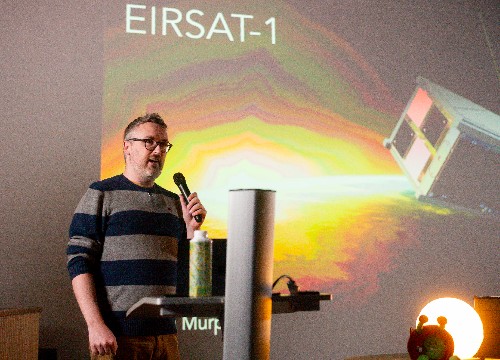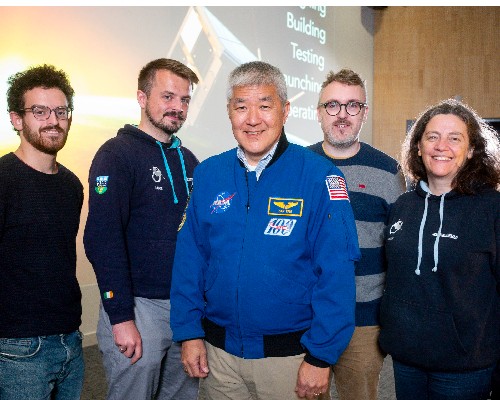 EIRSAT-1, the student-built satellite from University College Dublin that was launched into space last December, has detected two gamma-ray bursts on 21 August.
EIRSAT-1, the student-built satellite from University College Dublin that was launched into space last December, has detected two gamma-ray bursts on 21 August.
On World Space Week this October, the team behind the cubesat gave a talk at Dublin’s Explorium – the National Sport and Science Centre – revealing to the gathered young science fans the satellite mission success so far.
The miniature cube satellite, or cubesat, was designed, built, and tested at UCD under the guidance of the European Space Agency (ESA) Education division ‘Fly Your Satellite’ programme, and is Ireland's first-ever satellite.
One of the payloads on board the satellite is the gamma-ray detector – the Gamma-ray Module (GMOD). It has been the first experiment in-orbit to net a major success for the mission. The module was designed to detect bursts of high energy radiation emitted from the biggest, most destructive events in the universe such as the formation of a black hole from a collapsar (dying massive star) or the merging of neutron stars.
The Irish cubesat detected both its first and its second gamma-ray bursts within about 80 minutes of each other. Different spacecraft also reported these gamma-ray bursts, confirming the detections and validating the full GMOD instrument performance in-orbit – a great moment for the UCD team and the ESA Education ‘Fly Your Satellite’ programme, which hails EIRSAT-1 as a flagship project.
 Post-doctoral researcher in UCD Space Science Group and EIRSAT-1 Systems Engineer and GMOD Lead, Dr David Murphy (above right) revealed the news publicly at the talk in Explorium, joined by former NASA astronaut Daniel Tani (left) who was at UCD for World Space Week.
Post-doctoral researcher in UCD Space Science Group and EIRSAT-1 Systems Engineer and GMOD Lead, Dr David Murphy (above right) revealed the news publicly at the talk in Explorium, joined by former NASA astronaut Daniel Tani (left) who was at UCD for World Space Week.
David said: “It was incredibly exciting to downlink the data from GMOD and discover such clear unambiguous detections of these two gamma-ray bursts. Having spent so many years designing, building and testing the GMOD instrument as well as calibrating it and figuring out how to operate it in-orbit, these detections are an amazing validation of all the hard work put in by the team. It's astonishing to think that this satellite that we hand-built in our lab is now in space detecting photons that have travelled across the universe for billions of years to reach it. It's a real boost for us as we're beginning work on bigger and better space missions.”
Celebrating with team EIRSAT-1 at Explorium, Daniel Tani said: “This is fantastic news. What an inspiration that a few dozen students decided to design, fly and operate a satellite and not only successfully put their spacecraft into orbit but is now adding to the body of knowledge concerning gamma rays. This team, UCD, and all of Ireland should be very proud of their amazing accomplishment. I expect to see many more Irish satellites in orbit in the near future - followed closely by the first Irish astronaut!!
“I expect that Ireland will find that being a major player in space is good for business, education, and national spirit. I’m proud to meet the team that have put Ireland on the celestial map.”
On World Space Week, ESA congratulated the team on the “groundbreaking gamma-ray burst detections” on X, posting: “EIRSAT-1 is making waves in the scientific community, congratulations to the team and everyone involved!”
Exciting news from space: @EIRSAT1 has made it's first gamma-ray burst detections!
— ESA Education (@ESA__Education) October 8, 2024
EIRSAT-1 is Ireland’s first student-built satellite from @ucddublin, designed, built, and tested by talented students as part of @esa Fly Your Satellite! Programme.
This… pic.twitter.com/ULIMANOIc9
Gamma-ray bursts only last seconds or minutes but they are incredibly intense and can cross vast intergalactic distances to be picked up by GMOD. As EIRSAT-1 orbits earth from pole to pole, GMOD’s design and calibration enables fully optimised instrument performance when operational, as well as the ability to switch off to avoid overloading the on-board computer in high radiation regions around the poles, giving it the best chance of detecting the elusive gamma-ray bursts.
EIRSAT-1 Science Lead and gamma-ray expert, Professor Sheila McBreen said: "The detection of these bursts is a major milestone for the EIRSAT-1 mission and the GMOD instrument. GMOD was designed, built and integrated in UCD, all the code to run it was developed in UCD, and it is now working in-orbit and has detected events caused by end points of stars. We hope these events are the first of many detected by GMOD on EIRSAT-1 and future instruments we are already developing in the Space Science Group."
Optical light produced in the aftermath and environment of a gamma-ray burst can be used to measure its distance. To further examine the detected events, gamma-ray burst and pulsar expert at UCD, Dr Antonio Martin Carrillo and his collaborators used an eight-metre telescope at the European Southern Observatory (ESO) in Chile. They found that one of the gamma-ray bursts detected by GMOD is roughly 3 billion light years away and likely the result of two neutron stars merging.
He said: “After the detection of a new gamma-ray burst, as part of an international collaboration with a large ESO programme, my international colleagues and I search for its optical counterpart to find its distance. This is a fundamental step to understand the true energy power of these events.
"With the aid of other space and ground-based telescopes, we were able to pinpoint the sky coordinates of one of EIRSAT-1’s gamma-ray bursts. I coordinated a series of observations with the eight-metre VLT telescopes at Cerro Paranal (Chile) to gather the necessary data to constrain its distance. Its relative proximity and the properties of the optical counterpart seems to suggest that it was produced by the merger of two compact objects, likely neutron stars.”
See the technical details of the EIRSAT-1 and ESO discoveries on AlphaGalileo.
Listen back to Director of UCD C-Space Centre, Prof Lorraine Hanlon on RTE's Morning Ireland.
Prof Lorraine Hanlon @UCD_Cspace spoke to RTÉ @morningireland about @EIRSAT1's success in detecting gamma-ray bursts! #WorldSpaceWeek
— UCD Research (@UCD_Research) October 9, 2024
https://t.co/goQbqRsStR
These massive explosions in distant galaxies can help us to understand what the universe is made up of and how… pic.twitter.com/WRn7PkkbvO